Definition of Pronoun
A pronoun is a word that acts in place of a noun. Pronouns are one of the nine parts of speech, and there are also 9 types of pronouns:
Types of Pronouns
The most popular pronouns are the personal pronouns, but actually, there are nine types of pronouns:
- Personal Pronouns
- Possessive Pronouns
- Relative Pronouns
- Demonstrative Pronouns
- Reciprocal Pronouns
- Emphatic Pronouns
- Reflexive Pronouns
- Indefinite Pronouns
- Interrogative Pronouns
Examples of 9 Types of Pronouns
Trevor knows the secrets of life. He was told them by Emily. “He“ is an example of a pronoun, and look, it replaces the noun “Trevor.” “Them“ is also an example of a pronoun and it replaces the noun “secrets.”
Here is another example:
In Spain, apples are amazing. They look like cartoon apples. “They“ is an example of a pronoun, and it replaces the noun “apples.”
Look at the definition. I just want to change it a little bit. So, a pronoun is a word that replaces anything functioning as a noun. Let’s make the examples more realistic.
My best friend Trevor was told some business secrets. He was told them by Emily. “He” is our pronoun and it replaces the noun phrase “my best friend Trevor.” “Them“ is also a pronoun and it replaces the noun phrase “some business secrets.”
Let’s look at another example:
In Spain, the apples are amazing. They look like cartoon apples. So, the word “they“ is our pronoun and it replaces the noun phrase “the apples.“ So, a pronoun is a word that replaces a noun, but actually, it’s a word that replaces anything functioning as a noun, and that can be a single-word noun (as in our first examples), a noun phrase (like these), a noun clause, or even another pronoun.
Anything functioning as a noun can be replaced by a pronoun. And the thing being replaced has a particular name. Because, for every pronoun, there is an antecedent. So, wherever there is a pronoun, there is an antecedent — the thing being replaced.
Example Quote
This is a quotation by the actress Marilyn Monroe: A pronoun is a word that acts as a substitute for a noun.
“If you give a girl the perfect shoes, she can conquer the world. Well, “she” is our pronoun and it replaces the noun phrase “a girl.” If there’s a pronoun, there’s an antecedent, and the antecedent is “a girl.”
Example quote of pronouns
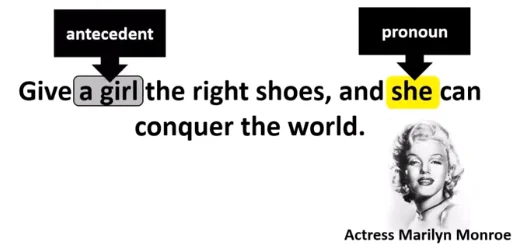
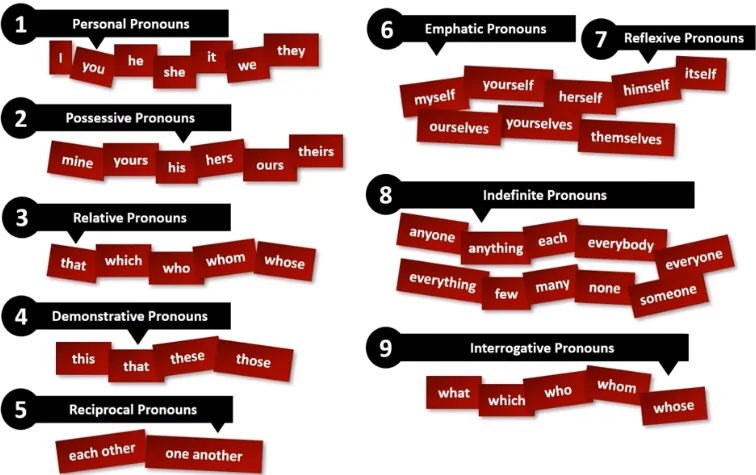
Personal Pronouns
Personal pronouns are one of the most popular types of pronouns that represent people or things.
| NO. | 1st Person | 2nd Person | 3rd Person |
| 1. | I | You | He |
| 2. | We | She | |
| 3. | They | ||
| 4. | It |
These are the eight personal pronouns. But, the first five are singular and the bottom three rows are plural. Here is an example:
A girl in my class is brilliant at languages. She speaks well. So, “she“ is our pronoun and it replaces “a girl in my class.” “A girl in my class” is the antecedent of the personal pronoun “she.”
My cousin, my sister, and my best friend are planning to visit Boston. They are earning money by washing cars. “They“ is our pronoun and it replaces the noun phrase “my cousin, my sister, and my best friend” which is the antecedent of the personal pronoun “they.”
There’s something else we have to say. Personal pronouns come in two forms. These are subjective pronouns, but you also get objective pronouns. They are:

Objective Pronouns
- me
- you
- him
- her
- it
- us
- you
- them
Again, the top five rows are singular the bottom three rows are plural.
When a personal pronoun is the subject of a verb, you use the ones on the left, but when a personal pronoun is not the subject of a verb, you have to use the list on the right. And, you can see that some of them change but some don’t, like these highlighted. Let’s look at two examples with objective pronouns.
- The young rascal has spirit.
- Throw him to the floor.
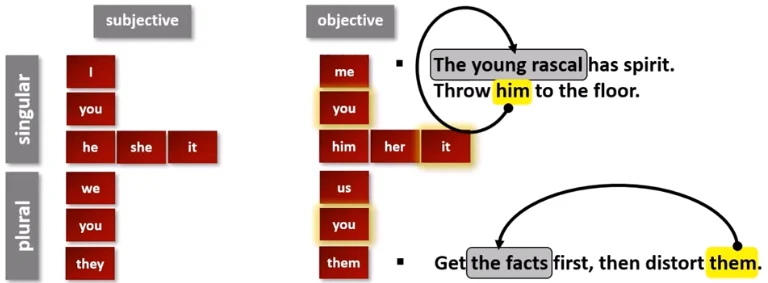
“Him” is the objective personal pronoun, and the antecedent is “the young rascal.” The word “him“ is not the subject; therefore, we have to use the objective version.
Here is another example:
Get the facts first, then distort them.
“Them” is an example of an objective personal pronoun it replaces the noun phrase “the facts” which is the antecedent. “Them“ is not the subject of “distort”; therefore, we have to use the objective version.
Possessive Pronouns
Possessive pronouns replace nouns and show possession.
The possessive pronouns are:
- his
- her/hers
- my/mine
- your/yours
- our/ours
- their/theirs
- its
Look at this picture:
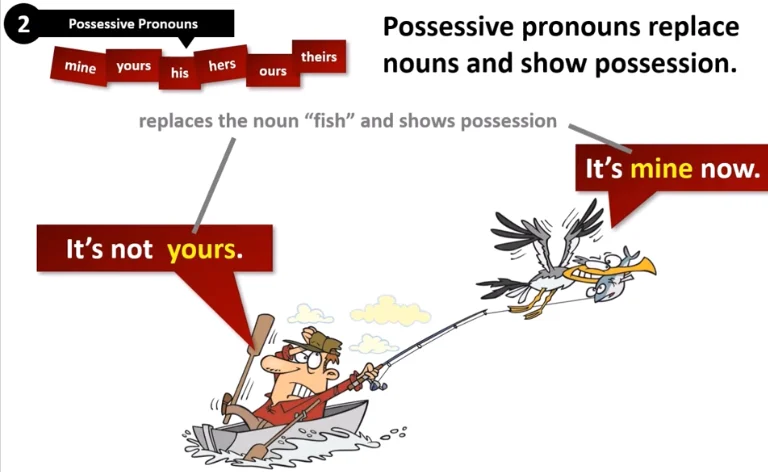
- “It’s not yours.” said the fisherman.
- “It’s mine now.” said the seagull.
So, this possessive pronoun replaces the noun “fish” and shows possession. “It’s not your fish”, “It’s my fish now”. So, you can see how the word replaces the noun “fish” and shows possession.
Relative Pronouns
A clause describing a noun begins with a relative pronoun.
Examples are:
- That
- Which
- Who
- Whom
- Whose
Examples
The man who stole your bike has been caught. So, this is our relative pronoun. This is the noun that’s being described. “The man”.
And this text in the red box is called an adjective clause, and notice that it’s headed by a relative pronoun. That’s one of the traits of an adjective clause (also called a relative clause.)
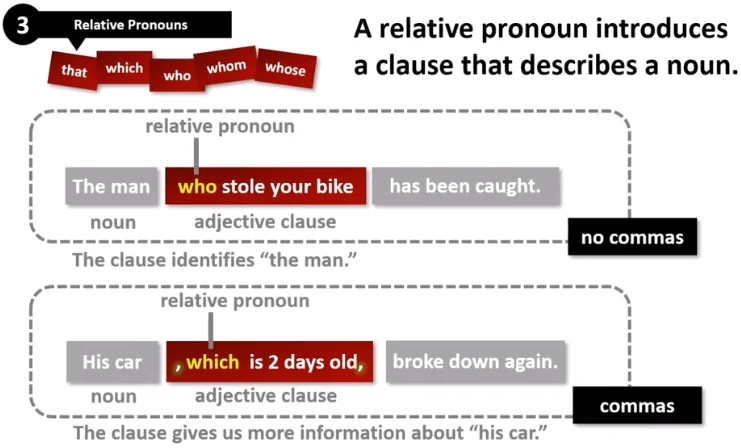
Let’s look at another example:
The relative pronoun is “which.” The noun being described is “his car.“ This is our adjective clause. So, a relative pronoun introduces a clause that describes a noun. You can see how this works. Think back to the definition of pronoun.
That’s what makes it a pronoun, and in the second one, the word “which“ represents the car in the clause, and that’s what makes it a pronoun. There’s one more thing to say about relative pronouns.
Look at this example:
- This clause identifies the man.
- The man who stole your bike.
- That tells us which man we’re talking about.
Notice that there are no commas.
Now, look at this example:
The clause just gives us more information about his car, it doesn’t identify his car. That has already been identified, so it’s just additional information. Notice that there are commas. This is a key point for relative pronouns. If the relative pronoun heads a clause that defines the noun, no commas. If it heads a clause that’s just additional information, commas.
Demonstrative Pronouns
Demonstrative pronouns refer to things previously mentioned or to something in the speaker’s surroundings.
- This
- That
- These
- Those
So, this is the speaker. She might say “this is my husband.” So, the antecedent is something in the speaker’s surroundings, not necessarily something in the sentence. The word “this” tells us that the antecedent is near and singular.
Examples
That is my mother. This time, the demonstrative pronoun “that” tells us that it’s something far and singular.
Let’s look at another example.
These are my children. “These,” tells us that the antecedent is near and plural. “Those“ are my friends. This time, the pronoun tells us that the antecedent= “those” is far and plural. So, a demonstrative pronoun tells us whether something is near, far, singular, or plural. So:
- This: near and singular.
- These: near and plural.
- That: far and singular.
- Those: far and plural.
The last thing to say is that it’s not always about distance. Because Demonstrative pronouns can also tell us whether things are near or far in time.
Reciprocal Pronouns
A reciprocal pronoun denotes a mutual action and relationship between or among persons and things.
Examples
- each other
- one another
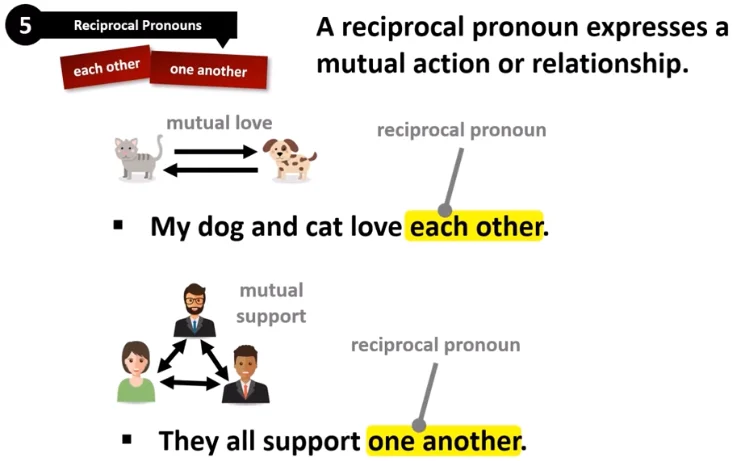
So, mutual love. My dog and cat love each other. So, this is the reciprocal pronoun.
Here is another example:
- Mutual support. They all support one another. “One another” is the reciprocal pronoun.
- In the first example, “my dog and cat” is the antecedent, and in the second example, “they” is the antecedent.
Emphatic Pronouns
An emphatic pronoun is paired with another noun to emphasize it.
- Himself
- Herself
- Myself
- Itself
- Ourselves
- Yourselves
- Themselves
- John can do it himself. So, look, “himself” is the emphatic pronoun, and it emphasizes “John.”
- Women must create the world they want themselves. “Themselves” is the emphatic pronoun, and it emphasizes “women.”
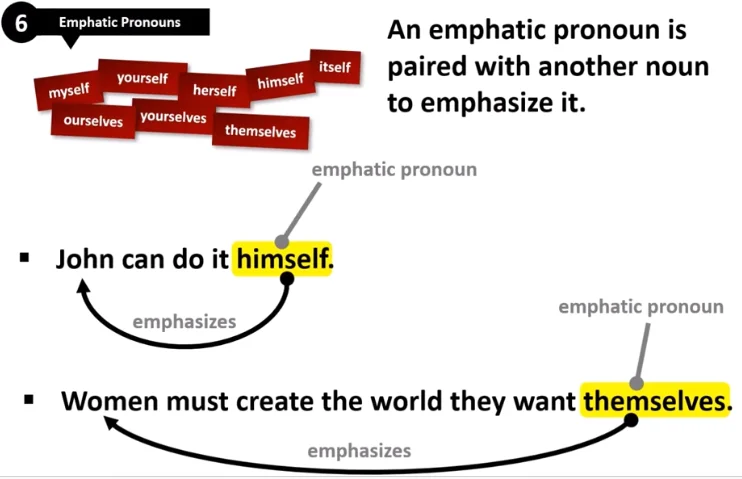
Reflexive Pronouns
A reflexive pronoun is paired with another noun to show it is acting on itself.
- Himself
- Herself
- Myself
- Itself
- Ourselves
- Yourselves
- Themselves
- My new watch corrects itself. This is the reflexive pronoun= “itself” and it reflects on my new watch.
- Peter and I checked ourselves for lice. “Ourselves” is the reflexive pronoun. It reflects on its antecedent “peter and I.”
Difference between Empahtic and Reflexive Pronouns
Notice that the emphatic pronouns and the reflexive pronouns are the same, but they have different roles. The emphatic pronouns emphasize. The reflexive pronouns reflect on them, but they are the same words.
Indefinite Pronouns
An indefinite pronoun refers to a personal thing without being specific.
- I have eaten everything in the fridge. “Everything” is our indefinite pronoun. We don’t know what it is. We just know it’s everything.
- I need to find something. We don’t know what specifically, but it represents something.
- I have nothing for breakfast. “Nothing“ is also an indefinite pronoun.
- There are lots of them.
Interrogative Pronouns
An interrogative pronoun is a kind of pronoun used to ask a question.
- Who
- Whose
- Whom
- What
- Which
- When
- Where
- Why
- How
- Who won yesterday? = who is our interrogative pronoun.
- What do you mean? =”What” is our interrogative pronoun.
Now, the last thing to say about interrogative pronouns is they don’t always feature direct questions. They can also feature indirect questions.
I want to know what this is. That is not a question. it is a statement, but it’s still an interrogative pronoun. The interrogative pronoun is used in an indirect question.
Recap of the Types of Pronouns
Hedgehogs? Why can’t they just share the hedge? So “they” are our pronoun, and it replaces the noun “hedgehogs.” “They” is a pronoun. “Hedgehogs” is the antecedent. Remember, if there is a pronoun somewhere there will be an antecedent.
The antecedent might not be in the same sentence. It might not be in the previous sentence. It might not be in the text at all. Remember, it can be something known to the speaker and the listener. Let’s remind ourselves of a few more examples.
Women must create the world they want themselves. Now, “themselves,” remember, is the emphatic pronoun, and its antecedent is “women. “The man who stole your bike has been caught.

“Who” is our relative pronoun and its antecedent is “the man.” These are out of date. Well, “these” is our demonstrative pronoun, and it replaces, well, something in the speaker’s environment — nothing in the text — so bear that in mind when you’re thinking about the different types of pronouns. A pronoun is a word that replaces a noun or something functioning as a noun.
Here are the nine parts of the speech:

